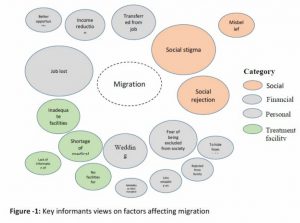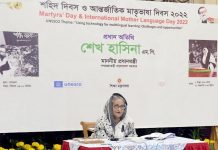Roton Malo
A recent study reveals that 57 percent of leprosy affected people (LAP) migrate from one area to another thanks to social stigma while 61 percent relocate for job loss in Bangladesh.
The information came through a study titled “Factors affecting migration, self-reporting and distant registration of leprosy cases in different prevalence area of Bangladesh.”
The study led by Professor Dr Quazi Zahangir Hossain, Environment Science Discipline, Khulna University, found five main factors of migration, relocation and movement of LAP in Bangladesh are– social stigma, social rejection, job loss, fear of being excluded from society, and inadequate treatment facilities.
According to the study, maximum 57 percent Key Informants (KIs) perceived that migration occur due to social stigma while 5 percent of LAP who has experience of migration for the same reason.
A total of 130 respondents from 17 hospitals in four divisions namely Dhaka, Chattogram, Rajshahi and Khulna were interviewed while 23 key informants (KI) from national level experts were also reached for the study.
One third of the KIs and 39 percent respondents in the study, said leprosy patients migrate from their own locality thanks to social rejection.
According the research findings, 24 percent respondents and 30 percent KIs agreed that fear of exclusion from society influenced migration of LAP.
The study findings also show that inadequate treatment facilities in local level forced 30 percent LAP to migrate from their own locality while 26 percent migrated for shortage of leprosy related professional doctors.
Altogether 80 percent of the KI opined that LAP migration increases the risk of spread of the disease into other areas specially when an untreated MB patient moves.
According to National Leprosy Programme, 3,976 leprosy cases were detected in 2015, a number of 3,001 cases in 2016 while 3,754 and 3,729 leprosy cases were diagnosed in 2017 and 2018 respectively. The number of new leprosy case detection was 3,638 in 2019.
The co-investigator of the research also Project Support Coordinator of The Leprosy Mission International-Bangladesh (TLMI-B), Mr Jiptha Boiragee, said the rate of migration of leprosy patients will reduce if treatment facilities can be arranged accordingly in local hospitals.
Wishing anonymity, a leprosy patient from Chandpur who was registered with the Institute of Leprosy Control & Hospital, Mohakhali, Dhaka, said “I noticed some skin patches in 2011 and my parents took me to many hospitals, pharmacies, quack doctors for seven years.”
“Finally, in 2018, I went to Mohakhali Leprosy Hospital and completed MDT treatment,” she said adding that my parents spent over Tk 1 lakh for me only to what the disease I had since 2011.
Dr Shafiqul Islam, outgoing manager of National Leprosy Programme (NLP), said “Aiming to stop migration of leprosy patients from one place to another, individual case-based tracking will be launched soon.”
However, it will take a few years, he said adding that once case-based tracking system is introduced, distant registration, migration will be reduced.
***The writer is a freelance journalist and attached with a Bangladesh-based leprosy-focused international organization.
































